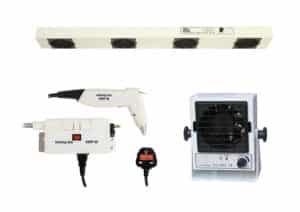Why are ionizers important to use?
The most significant environmental factor in ESD Control is the relative humidity (Rh). When humidity in the working environment decreases, the human body and other insulators can easily charge with static electricity due to friction. The air itself, being dry, becomes a part of the electrostatic build-up mechanism, every time an air flow (wind, air conditioning, blower) come over an insulated surface. Relative Humidity shall be maintained over 30%. Below that value it is recommended the use of ionization.
Conductors: Materials that easily transfer electrons (or charge) are called conductors and are said to have “free” electrons. Some examples of conductors are metals, carbon and the human body’s sweat layer. Grounding works effectively to remove electrostatic charges from conductors to ground. However, the item grounded must be conductive.
Insulators: Materials that do not easily transfer electrons are called insulators and are by definition non-conductors. Some well known insulators are common plastics and glass. An insulator will hold the charge and cannot be grounded and “conduct” the charge away.
Both conductors and insulators may become charged with static electricity and discharge. Grounding is a very effective ESD control tool; however, only conductors (conductive or dissipative) can be grounded.
Insulators, by definition, are non-conductors and therefore cannot be grounded. Insulators can be controlled by doing the following within an EPA:
- Keep insulators a minimum of 31cm from ESD items at all times or
- Replace regular insulative items with an ESD protective version or
- Periodically apply a coat of topical antistat
When none of the above is possible, the insulator is termed “process essential” and therefore neutralisation using an ioniser should become a necessary part of the ESD control programme. An ioniser creates great numbers of positively and negatively charged ions. Fans help the ions flow over the work area. Ionisation can neutralise static charges on an insulator in a matter of seconds, thereby reducing their potential to cause ESD damage.
Note: Ionisers require periodic cleaning of emitter pins and the offset voltage must be kept in balance. Otherwise, instead of neutralising charges, if it is producing primarily positive or negative ions, the ioniser will place an electrostatic charge on items that are not grounded.


